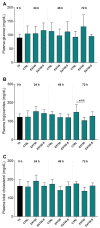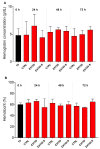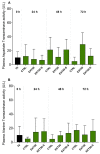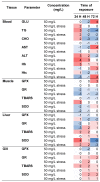Physiological Response of Atlantic Salmon (Salmo salar) to Long-Term Exposure to an Anesthetic Obtained from Heterosigma akashiwo
- PMID: 36006237
- PMCID: PMC9416519
- DOI: 10.3390/toxins14080575
Physiological Response of Atlantic Salmon (Salmo salar) to Long-Term Exposure to an Anesthetic Obtained from Heterosigma akashiwo
Abstract
Despite the invaluable role of anesthetics as a tool for ensuring animal welfare in stressful situations, there is currently a lack of anesthetic drugs that meet the requirements of intensive aquaculture. In response to the growing interest in anesthetic substances of natural origin, this study evaluated the physiological and health impact of an anesthetic based on an extract of the microalga Heterosigma akashiwo on juvenile salmon (Salmo salar) exposed for a period of 72 h. To simulate a condition closer to reality where fish are subjected to stimuli (e.g., transport), the animals were exposed to 50 mg L-1 of algal extract and to physical stress. Functional, physiological, and histological parameters were evaluated in blood and tissues at different sampling periods (0, 24, and 72 h). There was no mortality and the induction and recovery times observed were within the established criteria for anesthetic efficacy. The anesthetic extract did not induce any side effects, such as stress or metabolic damage, indicating that this extract is a viable option for supporting fish welfare during deleterious events. This study provides information to support that the anesthetic extract tested, derived from H. akashiwo, is a promising candidate drug for operations requiring sedation (e.g., Salmonid transport).
Keywords: Atlantic salmon (Salmo salar); natural anesthetic; physiological response; welfare practices.
Conflict of interest statement
The authors declare no conflict of interest.
Figures









Similar articles
-
Intestinal barrier function of Atlantic salmon (Salmo salar L.) post smolts is reduced by common sea cage environments and suggested as a possible physiological welfare indicator.BMC Physiol. 2010 Nov 9;10:22. doi: 10.1186/1472-6793-10-22. BMC Physiol. 2010. PMID: 21062437 Free PMC article.
-
Early-life environmental enrichment promotes positive animal welfare for juvenile Atlantic salmon (Salmo salar) in aquaculture research.Sci Rep. 2025 Feb 18;15(1):5828. doi: 10.1038/s41598-025-88780-0. Sci Rep. 2025. PMID: 39966558 Free PMC article.
-
Hydrogen peroxide treatment in Atlantic salmon induces stress and detoxification response in a daily manner.Chronobiol Int. 2016;33(5):530-42. doi: 10.3109/07420528.2015.1131164. Epub 2016 Apr 8. Chronobiol Int. 2016. PMID: 27058450
-
Cardiomyopathy syndrome in Atlantic salmon Salmo salar L.: A review of the current state of knowledge.J Fish Dis. 2018 Jan;41(1):11-26. doi: 10.1111/jfd.12735. Epub 2017 Oct 24. J Fish Dis. 2018. PMID: 29064107 Review.
-
Atlantic salmon (Salmo salar L.) genetics in the 21st century: taking leaps forward in aquaculture and biological understanding.Anim Genet. 2019 Feb;50(1):3-14. doi: 10.1111/age.12748. Epub 2018 Nov 14. Anim Genet. 2019. PMID: 30426521 Free PMC article. Review.
Cited by
-
Hematological and Biochemical Parameters of Subadult Captive Siberian Tigers (Panthera tigris altaica).Animals (Basel). 2025 Apr 30;15(9):1299. doi: 10.3390/ani15091299. Animals (Basel). 2025. PMID: 40362115 Free PMC article.
References
-
- Sadoul B., Vijayan M.M. Fish Physiology. Volume 35. Elsevier Inc.; Amsterdam, The Netherlands: 2016. Stress and Growth; pp. 167–205.
-
- Priborsky J., Velisek J. A Review of Three Commonly Used Fish Anesthetics. Rev. Fish. Sci. Aquac. 2018;26:417–442. doi: 10.1080/23308249.2018.1442812. - DOI
Publication types
MeSH terms
Substances
LinkOut - more resources
Full Text Sources

